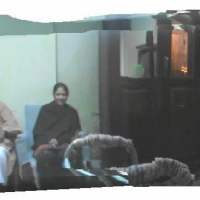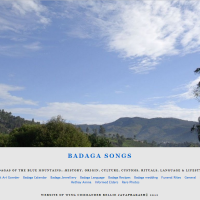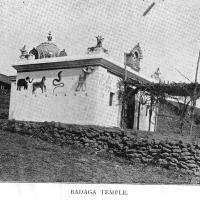Minor Languages of South India
– Dr.R.K.Haldorai

According to Dr.Caldwell, the well known Dravidian linguist, the two minor languages of the South India, Toda and Kota are uncultivated languages. He included the minor languages, Tulu and Kodagu into cultivated group. He mentioned very little about the Badaga language which is also a remarkable minor language of South India. Besides these languages Kurumba, Irula, Kasaba etc., are the minor languages spoken in South India. However, among these languages Tulu, Kodagu, and Badaga are the languages which have more number of speakers. The rest tend to be spoken by rather small group (in almost all the cases less than ten thousand speakers) of tribes often in isolated areas.
Tulu, Kodagu and Badaga are non tribal languages but not literary. These three languages are also ancient languages of South India and important members of the Dravidian group of languages. Including these three all the minor languages of south India have no scripts of their own.
Tulu is spoken in the region called Tulu Nadu lying on the west coast of South India, comprising the major sector of the district of South Kannara situated in the Karnataka State and the people whose mother tongue is Tulu are called Tuluvas. Kodagu is spoken in the hilly region of Kodagu district of Karnataka state and the people whose mother tongue is Kodagu are called Kodagas or Kodavas. Badaga is spoken in the hilly Nilgiris district of Tamil Nadu and the people whose mother tongue is Badaga are called Badagas.
Badagas identify their living place, Nilgiris district as “naakku betta” i.e. (surrounded by) four hills, these groups are identified with their respective mother tongues. Speakers of these minor languages are seen in urban centers in South India. Sizeable speakers of these languages have migrated to the nearby places, especially cites of South India.
These languages themselves are interesting to study and the study of such languages is also important from the point of view of the culture, habits and the social attitudes. It is a matter of regret to note that most the speakers of minor languages do not know much about their own languages. Of course, their ability to talk is unquestionable. The need of the hour is, we should devise a mechanism that can induce these speakers to know about their own languages. These people feel that their languages are poor versions, as they have no written forms.
If there is a priority between written and spoken language, it is the spoken form which comes first and not the written form of language. It is to be kept in mind that spoken language precedes the written language historically. The written languages were once vogue in spoken forms only. Even the speakers of a written language learn to speak long before they learn to write. Linguists made it clear that unlettered language is no way inferior to any lettered language. The speakers of these languages should know that their language has still not attained the written form because of lack of their own enthusiasm.
Fortunately, these languages (Tulu, Kodagu and Badaga) are best described by linguists and others. Now, linguists are able to cope up with any language in the world, whether or not it has ever been written down. Indeed, this is one of the most beneficial aspects of modern linguistics. Therefore, it is wise to utilize the service of these scholars for the development of their own languages.
Most of the speakers of the minor languages are bilingual. Besides their home language, they speak the local official language pretty well. The official language of Tulu and Kodagu speakers is Kannada and Tamil is the official language of Badagas. Some time these people identify themselves with the speakers of official language, especially during meeting with outsiders. However, there is hardly any chance of them conversing in other language with their own men.
Kodagu speakers are surrounded by Kannada, a literary language and Tulu is surrounded by two major literary languages viz. Kannada and Malayalam. But the peculiarity is seen with the Badaga speakers, they are surrounded by three major literary languages viz. Tamil, Kannada and Malayalam. Their habitation, the Nilgiris is situated in the place where these three languages are meeting. Fortunately, the official languages of these groups belong to the family of language (Dravidian) which their own languages belong. Hence, these people learn the official language with ease.
Most of the people think that spoken language has no grammar and they restrict grammar for the written language. But from the linguistics point of view, spoken language certainly has a grammar. It is to be noted that the foreign and Indian scholars produced good descriptive grammar of these languages and they have translates some of their songs, folk-stories, ballads, proverbs etc. Most of the scholars use Roman script with diacritical marks wherever found necessary for writing these languages. The modern linguistics devices alphabets for languages. In fact, it appears as a pretty good aid in combating illiteracy.
To our dismay, these activities are helping to the scholars and others as reference materials, but not properly utilized by the speakers of these languages. In many cases, the speakers of these languages do not know about these studies and its importance. However, it is well and good when these people evince interest in utilizing these studies.
More or less all these three languages are highly developed with rich vocabularies. Among these languages, Tulu is more refined and it is capable of expressing the most subtle shades of meaning in appropriate terms. The antiquity of Tulu goes back to the Sangam age of Tamil literature. Tulu has produced a good many number of dictionaries. Some books have been printed in Kannada script. In Kodagu too, there is some activity of writing by adopting the Kannada script. But in the case of Badaga, it is a matter of regret to note that almost there is no activity of writing so far. Unlike Tulu and Kodagu, Badaga speakers rarely use to write their mother tongue. Mostly they use Tamil for external connection.
For a longer period Badags was maintained under ambiguous status between a language and a dialect. Badaga was relegated by few scholars to the position of dialect of Kannada, a dominant literary language in the vicinity. The multi-lingual Nilgiri hills fascinated many eminent scholars. But due to the relegation to the position of a dialect might have left the Badaga language in lurch as the other languages like Toda Kota caught attention of many linguistic and anthropological scholars. Somehow, of late the Badaga is studied by international acclaimed scholars. At the same time few indigenous scholars too studied Badaga language and produced few reference materials.
In fact, Badaga is an independent language with antiquity matching if not surpassing the other literary languages. Earlier scholars expressed their views superficially on Badaga language with their little collected materials. However during the recent past, especially during the closing decades of 20th century scholars studied the Badaga language thoroughly and exposed its status as independent language.
Even a cursory study of the vocabularies of these languages will tell us that these languages have been languages of highly civilized communities from the earliest time. Kodagu and Badaga languages have a small number of Sanskrit words comparing with Tulu. The primitive indigenous words can present a vivid picture of the simple life of these ancient people. In fact, these languages preserved more of their archaic features and intensive study of them will certainly clarify several issues in their linguistic pre-history.
The importance of the study of non-literary language cannot be minimized. There is a vast amount of literature seen in Tulu and Kodagu. All these minor languages have got traditional oral literature which has to be collected and studied. In fact, the importance of the oral literature is great. Collection of folklore and the folk songs is an urgent task. The rapidly changing scenario will engulf all these things without leaving any trace if they are not documented in time.
The study of minor languages of the South India has spanned a period of nearly two centuries. But what has been done is meager and much remains to be done. Mostly missionaries and foreign scholars had written grammars and associated materials. Dravidian linguists, mostly university scholars collected vocabularies and other linguistic materials and they paved the way for writing down these languages. Among these minor languages only Badaga has to adopt a script to elevate its position as a lettered one. Good many Badaga dramas and songs were written in Tamil script during the last few decades. With this one can assume that attempt to make Badaga as a lettered language is already begun and resuming that will make it as a literary language.
 Feb 24, 2017
Feb 24, 2017













 Mookuthi
Mookuthi  Chinna
Chinna 






 ==
==




![Seemae [See'may] & Morae [Mo'ray] (relationship)](https://i0.wp.com/badaga.wordpress.com/files/2008/11/nakku-betta1.jpg?resize=200%2C200)







































